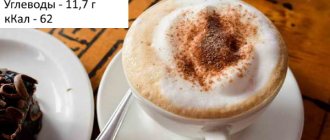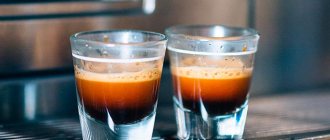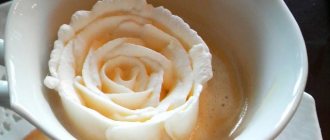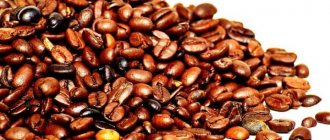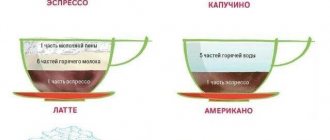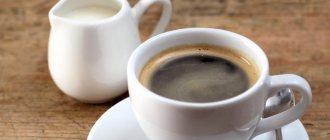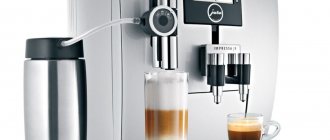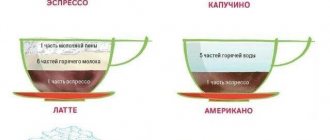Latte is a hot, layered coffee, medium-calorie drink made from 1 serving of espresso, milk and milk foam. Italy is considered the birthplace of the drink.
It was there that Italian housewives, to please children who wanted to be like their parents who drank coffee in the morning, diluted the strong drink with milk, “staining” it a little. The word “stained” is where the name “latte” comes from, which later became one of the most popular drinks in Europe.
Calculating the energy component of a latte
There are no standard volumes for the cocktail. It is prepared for dishes of different sizes. 120-480 ml. For a cappuccino, a dairy product is heated and then turned into foam. In a latte, the milk component is used in the entire serving size, with not very tight, loose foam.
The classic latte variation is espresso with the addition of whipped milk ingredient.
If you are preparing a macchiato, then pour milk into a cup or glass, and then add espresso in a thin stream. The calories remain the same in both the first method and the second.
Calorie content of coffee (per 100 g of product)
So, these are the characteristics of the initial raw materials. Let's calculate the searched values.
As you can see from this data, the lowest calorie coffee is granulated. To this day, many people continue to drink this drink. On average, take 2 tablespoons of coffee for one 200 ml cup. In our case, one spoon is approximately 8 grams of raw materials.
In the end, we get 15 grams for one finished mug.
Conclusion, 1 cup of instant coffee contains about 14 calories
Let's move on. Let's calculate how much energy a mug of drink made from beans or ground coffee will give us.
For calculations, we will again take 2 tablespoons of raw materials per cup. These characteristics are adhered to in most recipes, for Turkish coffee, in coffee machines, etc. Accordingly, we will need 15 grams of coffee. We carry out ordinary calculations and get the result.
A cup of whole grain coffee, about 33 calories. A cup of ground coffee, about 30.
You can see the remaining characteristics in the table. What can be noted. Natural bean coffee can be safely consumed before sports training. They contain proteins necessary for muscle growth, as well as carbohydrates that saturate our body with energy. This is a completely acceptable energy drink.
But we completely forgot about sugar. If you add it to a ready-made drink, then add 30-32 calories per spoon. If we add 2 teaspoons to our coffee beans, our drink will end up containing about 100 calories.
Now you have everything you need for the calculation.
Calculating the calorie content of a latte
Coffee contains 1 to 2 kcal calories. If large glasses contain a double or triple shot of espresso (60, 90 grams), there will be 2 kcal. This is an insignificant figure if we take a person’s entire daily diet and its energy value.
Institutions and coffee shops are content with a milk component of 2.5% standard, mass fat content.
It produces foam, and its taste is neither watery nor too greasy. And such cocktails contain 52 kcal per 100 ml.
A latte is prepared with a dairy product and the result is:
- 120 ml contains 90 ml of milk, energy value 47 kcal;
- 180 ml -120 ml, 62;
- 240 ml – 180 ml, 94;
- 450 ml – 340 ml, 177.
Coffee establishments prepare cocktails that differ in milk fat content. In homemade cocktails, the caloric content is also different:
- in packaged, 100 grams of skim milk, there are 34 kcal.
- 1.5% - 44 kcal;
- ordinary - 2.5% - 52%;
- purchased in a store - 3.2% - 58;
- fat 3.5% – 61;
- whole – 64;
- soybean 0.1% - 28;
- soy 0.6% -43.
If you want to know how high the calorie content of a latte is, and how many kilocalories you will get by preparing your glass of latte, then divide the number of kcal by 100 and multiply by the volume of glassware used.
Note to latte lovers
Coffee is a well-known natural antioxidant and energy booster. Coffee beans contain alkaloids, which have an invigorating effect on the body. But as soon as you start abusing such a drink, immediately instead of vigor and a surge of strength, a person feels tired, weak and drowsy.
Oddly enough, even roasted coffee beans contain useful components.
Compound:
- magnesium;
- sodium;
- phosphorus;
- ferrum;
- sulfur;
- calcium.
On a note! If you abuse coffee, calcium will be washed out of your body. That's why it's better to add pasteurized milk to the drink and make a delicious latte.
Today we're talking about lattes. This coffee is incredibly beneficial for humans.
Beneficial features:
- elimination of drowsiness;
- increasing male potency;
- restoration of the body after grueling mental or physical stress;
- prevention of a number of liver diseases, Parkinson's disease;
- prevention of premature aging of the body;
- prevention of cancer;
- improvement of well-being during stress;
- antioxidant effect on the body.
But it is appropriate to talk about beneficial properties when you drink no more than 1-2 cups per day. But too much coffee can cause harm. Scientists note that excessive consumption of this drink has the opposite effect on the human body.
There are also contraindications to drinking latte that should be taken into account. If you are struggling with excess weight, then it is better to avoid coffee with milk filling, especially with syrups and granulated sugar. Contraindications also include high blood pressure and cholecystitis.
Important! If pancreatitis worsens, it is better not to drink coffee at all. This also applies to lattes. Try to replace the drink with herbal infusions or freshly brewed tea.
Coffee sweet drink
With the most delicate foam and creamy taste, this cocktail is simply mesmerizing. And it is impossible to refuse it, especially for the fair sex. Even if you’re on a diet, after it’s over, your favorite morning milk and sweets, albeit not every day, but once a week, are an undoubted attribute of your mood for the whole day. You can count calories and think about compensating for sweetness.
Basically, they use 2.5% milk. If in tsp. up to 8 grams of sugar, that’s up to 30 kcal.
- A glass of 120 ml - 47 kcal, with 1 teaspoon - 77 kcal, with two - 107 kcal.
- 180 ml – 62 kcal, 1 tsp. – 92, with 2 – tsp. – 122 kcal.
- 240 ml – 94, with 1 tsp. 124, with 2 – 154 kcal.
- 450 – 177 – with 1 tsp. – 207, with 2 tsp. – 237 kcal.
Syrups can add 35 – 40 kcal per 10 ml. Then do the math for yourself.
Sweeteners
Those with a sweet tooth increase the nutritional value of a coffee cocktail by using sugar and syrup. One teaspoon contains 5 g of granulated sugar, which is 20 kcal. The energy value of syrup may vary slightly among different manufacturers, but on average it is also about 20 kcal per 5 grams. Therefore, a spoonful of sugar + a spoonful of syrup adds 40 kcal. Usually 240 ml (100 kcal) per cup of drink is enough. 100+40 = 140 kcal per serving. Let's calculate the calorie content of a latte with syrup: 140/250 (volume)*100=56 kcal/100 g.
Calorie content of bagged latte
This is a sweet dry powder. It contains dry milk extract and flavoring. Some manufacturers add components that look like foam, but of course, this is far from the original. A natural, freshly prepared coffee cocktail cannot be compared in any way.
Packets containing sweeteners, concentrated milk solids and unsaturated flavors. And to increase the sweetness of the drink, sugar is added and the calorie content increases.
It’s easy to calculate how many calories a latte contains in such a serving. The nutritional value will not change whether you drink from a large cup or a small one. As you know, soluble components are not absorbed by the body, but are deposited. And then the figure suffers.
What makes a drink high in calories?
In addition to coffee beans, a latte necessarily contains milk and sugar. Sweet flavored syrups make the taste range more diverse. Sometimes chocolate and cinnamon are added in small quantities, which also carry a few calories. As a result, based on dietary espresso, you get a coffee cocktail with a calorie content that corresponds to a full-fledged dessert.
The energy value consists of the nutritional value of the components: espresso, dairy component, sugar and other sweeteners. Portion size also matters.
To summarize all of the above
- In medium latte cups, without adding sweeteners, you will get 62 - 94 kcal.
- Energy components depend on the amount of milk product, including its fat content.
- Sweets together with syrups provoke an increase in the value of energy components: 1 tsp. sugar, about 30 kcal. The syrup is about 40 kcal.
- A latte made from coffee aggregates is approximately similar in energy value to a conventionally prepared one. If you are thoroughly concerned with counting calories, then it is better to skip this option.
- Coffee shops offer large portions of lattes with additives. This is approximately 250 -280 kcal, not counting sweeteners.
Dark coffee:
Coffee has always been a very popular and beloved drink by many.
It has been known in Europe since around the seventeenth century. It gained its popularity thanks to its wonderful smell and tonic properties. The methods for making this drink and serving methods are very different. The most popular is simply dark coffee. Many, in order to improve or make the taste of this drink more varied, add sugar or liqueur to it; it is also very popular with cognac, as well as with a slice of lemon. This drink helps the human body produce the so-called “happy hormone”, serotonin. In addition, it perfectly invigorates in the morning and has the ability to improve blood circulation in the brain cells, stimulates the work of internal organs - the heart, kidneys, lungs.
Coffee beans contain about 2 thousand substances that shape the health effects of coffee. Among them are water, caffeine 0.65-2.7%, fat 12%, proteins 13%. During the roasting process, the composition of the coffee beans changes. The degree of configuration depends on the degree and duration of roasting. Namely, the caffeine content increases to at least 1.3%. And in the process of making instant coffee, the caffeine content generally increases to at least 5%. Also, considering the effects of coffee on health, it must be said that coffee beans contain potassium, calcium, magnesium, iron and other trace elements. Roasted coffee beans contain vitamin PP, pyridine and other vitamins.
Coffee contains caffeine up to 1500 mg/l.
Caffeine is a psychostimulant and has a stimulating effect on the nervous system. Under the influence of caffeine, cardiac activity accelerates and blood pressure rises. Caffeine increases and regulates excitation processes in the cerebral cortex; in appropriate doses, it increases positive conditioned reflexes and increases motor activity. The stimulating effect leads to an increase in intellectual and physical performance, a decrease in lethargy and drowsiness.
The effects of caffeine last for several hours. Then, unfortunately, lethargy occurs.
What is the calorie content of coffee? Of course, the number of calories in this popular drink directly depends on the method by which it is prepared. Pay attention to this table:
How many calories are in coffee?
Coffee is known, first, for its tonic and invigorating effect. Many people don’t like it, and some can’t imagine their life without it. But everyone who cares about their own figure is interested in the question of the calorie content of coffee. Can it hinder weight loss or, on the contrary, help you lose a few extra pounds?
We offer you a variety of coffees with added milk
There are many of them, choose to your liking:
- Latte coffee has the highest milk content in espresso, ¼ of the volume or two shots per serving of brewed coffee.
- Cappuccino contains equal amounts of milk and espresso.
- Macchiato with a thin layer of milk foam and espresso coffee.
- Latte macchiato – layers of milk and milk foam.
- Mocha - a combination of chocolate, milk, milk foam, espresso.
- Flat white, an Australian drink, contains espresso and a small amount of steamed milk.
- Brauner, the Austrian version, has a lot of milk and a little coffee.
- The French cafe oh-le also has a lot of milk and little coffee.
- Brave milk and cream are added to espresso.
- Honey raffe, honey is added as the first layer, then espresso, and frothed milk completes the composition
Kinds
Latte without sugar (the calorie content of the drink when using 2.5% milk is no more than 93 kcal) is a popular coffee drink in Europe. Unlike cappuccino, latte according to the classic recipe is prepared from 1 portion of espresso (30-50 ml) and 4 portions of milk, as a result of which the drink has a pleasant sweetish creamy milky taste and low strength.
In modern coffee shops, a variation is more common, in which 80 ml of espresso (2 servings) and 4 servings of milk (120-150 ml) are used. This drink has a strong strength and is suitable for lovers of coffee and milk mixtures, decorated with abundant foam.
When preparing, coffee is poured into the whipped, loose milk foam in a thin stream, then syrup is added if desired and decorated with cinnamon or chocolate chips.
There are several types of milk-coffee drink:
- Cinnamon , in which cinnamon powder or stick is added to garnish the foam;
- With syrups . Syrups add sweetness to the latte and are added to the glass before foaming the milk. Vanilla, caramel, and nut syrups are best suited for this drink. It is not advisable to take fruit ones, as they can cause fermentation of the milk mixture.
- Vanilla. Prepare with the addition of a vanilla bean (or vanillin) when whipping the milk mixture.
- Caramel . Requires the use of caramel syrup or caramel added to the whipped milk.
- With ice cream . A traditional recipe in which an additional scoop of vanilla ice cream is added to the coffee and milk mixture.
- Autumn . A fashionable option used for Halloween. Consists of adding pumpkin puree to the drink for decoration.
- Black latte . A recipe developed by nutritionists and requiring a replacement for coffee 1 tab. activated carbon.
How many calories are in a latte from common brands that sell milkshakes?
- A 480 ml cup of Starbucks caramel contains 250 kcal.
- 480 - Starbucks nut -190.
- 360 - McDonald's - 140.
- 480 - McDonald's - 210.
- 250 - in the classic Coffee House - 111.
- 250 - in low-fat Coffee House -73.
- 360 — vanilla coffee Bean -210.
- 480 - classic Bean coffee -260.
- 330 - in Coffeemania - 156.
- 450 - in Coffeemania - 218.
- 400 - in Shokoladnitsa - 220.
- 320 - in Shokoladnitsa light -125.
If life without coffee is not sweet, and you want to eliminate the calories you consume, then reduce the amount of sugar and additives. Of course, you can only use the best option, which does not contain many calories. This is a simple espresso. But sometimes you want something tasty. Therefore, the choice is yours.
Energy value
It is included in the diet of most diets, and the reason is that by itself it actually has no kilocalories. Initially, coffee beans contain a huge amount of carbohydrates, fats and essential oils. But during the roasting process, the level of fat decreases greatly, so the nutritional value of the drink tends to zero. In addition, not all substances in grains are water soluble, so not all calories will end up in the cup.
But this is true exclusively for coffee beans and only when it is drunk completely without additives.
Recipe with cocoa powder
Coconut juice is not easy to come by. Usually it is released with impurities, that is, not in a “pure” form. Modern baristas have found an alternative in the form of condensed milk. However, the invigorating drink with its addition does not have a rich aroma.
Coffee made with coconut milk with the addition of cocoa powder is one of women's favorite drinks. Its consistency is dense, the smell is amazing, and the taste is rich and memorable.
Ingredients:
- coconut fruit juice;
- Arabica beans;
- granulated sugar;
- cocoa powder;
- brown sugar (optional);
- ice (optional);
- mineral water.
Cooking method:
- You need to make a powder mass from Arabica beans. To do this, we recommend using a coffee grinder. Processing time – 1 minute.
- Brew strong espresso from the resulting raw materials. If you have a sweet tooth, add granulated sugar to it. Stir the drink well and leave it to cool.
- Use a blender to blend the remaining ingredients: cocoa powder, brown sugar, ice (if using), and some water. The last ingredient is necessary to ensure that the coffee is not very concentrated.
- Pour the prepared drink into a glass glass with thick walls. Enjoy the pleasant chocolate taste.
If you decide to treat yourself to sweet cocoa-based coffee in winter, then adding ice to it is not recommended. This puts you at risk of getting sick.
Benefits of coconut milk
The beneficial properties of coconut milk include:
- in cosmetology, this product is widely used to make masks for hair, face and body,
- lauric acid in coconut milk is characterized by pronounced antiviral, antifungal and bactericidal properties,
- the product stimulates the functions of the immune system, providing effective prevention of colds,
- with constant consumption of coconut milk, the elasticity of the blood vessels of the circulatory system improves, thereby minimizing the risk of developing diseases of the cardiovascular system,
- the antioxidant characteristics of such milk make it possible to use it for the prevention of cancer,
- the product helps normalize hemoglobin levels, blood sugar, has a beneficial effect on blood pressure characteristics,
- this is a suitable alternative to cow's milk for lactose intolerance,
- the product does not contain gluten, to which many people develop allergic reactions,
- Coconut milk stimulates the stomach and intestinal tract, which accelerates metabolism and activates weight loss processes.
Coconut milk toxicity
Among the harmful parameters of coconut milk, it is necessary to emphasize:
- some people have a personal intolerance to the product,
- Abuse of coconut milk leads to disruptions in the gastrointestinal tract, including flatulence, bloating, difficulty with bowel movements,
- due to the high fat content and high calorie content, such milk is limited in the diet if you are overweight and during a diet,
- Full-fat coconut milk increases bad cholesterol levels,
- careless manufacturers add sweeteners, artificial additives and preservatives to coconut milk. Such ingredients do not bring benefits to the body, they reduce the amount of necessary substances in the product,
- the possibility of consuming coconut milk is agreed with the treating doctor for cholecystitis, pancreatitis, inflammatory processes in the liver, stomach, and intestinal tract.
FitAudit website is your daily nutrition assistant.
Truthful information about food products will help you lose weight, gain muscle mass, improve your health, and become an active and resilient person.
You will find a lot of new products, learn their real benefits, and remove from your diet those products that you had no idea were harmful before.
All data is based on reliable scientific research and can be used by both amateurs and professional nutritionists and athletes.
Calorie content of Starbucks drinks and dishes.
A cup of fragrant coffee with a wonderful cake or dessert is an ideal pastime for many. But very frequent visits to cafes can affect your figure. Therefore, people watching their weight are probably curious to find out about the energy value of the dishes offered by their favorite establishment. Now we will talk about the calorie content of the Starbucks menu.
Currently, the Starbucks coffee chain can be found in almost every town in the world. The establishment has become the most popular and profitable in its own direction, surpassing its rivals.
Is coconut milk added to coffee?
Definitely yes! In Thai cuisine it is used to prepare soups, baked goods, and many other dishes and drinks. And in principle, it is not too different from almond (also a nut) or even soy, only it is usually fattier, oilier, and can be a little thick.
Coconut milk is obtained from processed nut meat. This is not the same as the juice that is found inside the nut. If you break a coconut, the juice will pour out, but to get milk you need to grind the pulp with water and strain the liquid.
In stores you can find canned food packaged in metal cans, drinking milk cartons (cardboard-metalized tetrapacks, like juice), as well as cream or dry powder. You can also cook it yourself.
Is coconut milk good with coffee?
Surprisingly, the product itself is not similar to Bounty bars or coconut flakes. It does not have a pungent odor or sweet taste; rather, it is more neutral and not sweet, which is why it is used for preparing soups and main courses. It's something closer to thick sour cream, with a light aroma and a subtle, subtle taste, like other nut milks.
In the taste, first of all, you can feel the creaminess, fat content, the drink turns out a little thick, smooth - as if you poured high-quality fatty homemade milk into it. There is a low-fat version, but it also tastes quite thick and creamy.
Judging by reviews online, coconut milk with coffee is liked by most of those who try it. And even if you don’t like coconut desserts, it’s worth trying to make such a cocktail.
Making milk from chips
You can use the tropical nut to make delicious milk. To do this you will need to take its pulp. But if a simpler and more interesting option is making coffee with coconut flakes.
Components:
- mineral water;
- tropical nut juice;
- coconut flakes;
- fatty cow's milk.
Take a container and fill it with water, milk and shavings (the amount of liquids should be the same). It is placed on the stove to simmer for at least 5 minutes. During this time, foam will begin to form. Remove it with a spoon.
Strain the hot mixture using cheesecloth or a sieve. Squeeze the main raw materials well. The prepared liquid must be placed in the refrigerator to infuse. Duration – 1 day.
Do not throw away the pulp remaining after filtration. You can make delicious cookies from it.
Treat yourself to an aromatic sweet drink by making espresso and adding the preparation to it.
Background
At the end of the twentieth century in America, three people with the most ordinary professions (teachers and a writer) decided to do something special, change their lives and start all over again. The friends had a lot of thoughts, but while thinking about their next project over a cup of coffee, they came up with the main idea - opening a store where they could sell the beans of this drink.
Having recreated the idea, they held tastings from time to time until they realized that people would rather not sit at home with hot coffee, but spend time in a comfortable establishment with company. And soon the store retrained into a coffee shop. This served to expand it and create a whole network of Starbucks cafes. The menu also expanded, first adding desserts and other drinks, and then main courses and breakfasts.
Nutritional value of coffee latte
Coffee machines usually use a milk product with 2.5% fat content. Its nutritional value is 52 units per 100 g. A standard plastic cup is 200 ml, and a portion of 180 ml is poured into it. In other words, on average, this is 120 grams of milk, as we already calculated earlier. The calorie content of the finished drink is about 62, sometimes even less (we don’t know what specific dairy products are used by a particular brand). This is provided that you drink a latte without sugar. Each stick will add another 20 kilocalories. We added two and got a nutritional value of 102 kcal.
These data are for natural espresso and dairy ingredients. But coffee makers do not always use these specific ingredients. Quite often you can find soluble powders and concentrates.
Features of use for weight loss
Thanks to the increased content of epigallocatechin, matcha latte promotes weight loss. However, it must be borne in mind that the cocktail provides a tonic effect and is not the main fat burner.
It helps reduce appetite and eat less food. The matcha latte drink will be effective in a combination of measures - with proper nutrition, within the calorie norm, and with active physical activity.
When drinking matcha latte, you need to drink enough water, up to 2 liters per day. For greater effect, add cinnamon to your tea, which helps burn fat.
A wonderful addition would be the delicate taste of mint and lemon. Start taking the cocktail with small doses, but no more than 2 cups per day. Before using the product, it is advisable to consult a doctor.



